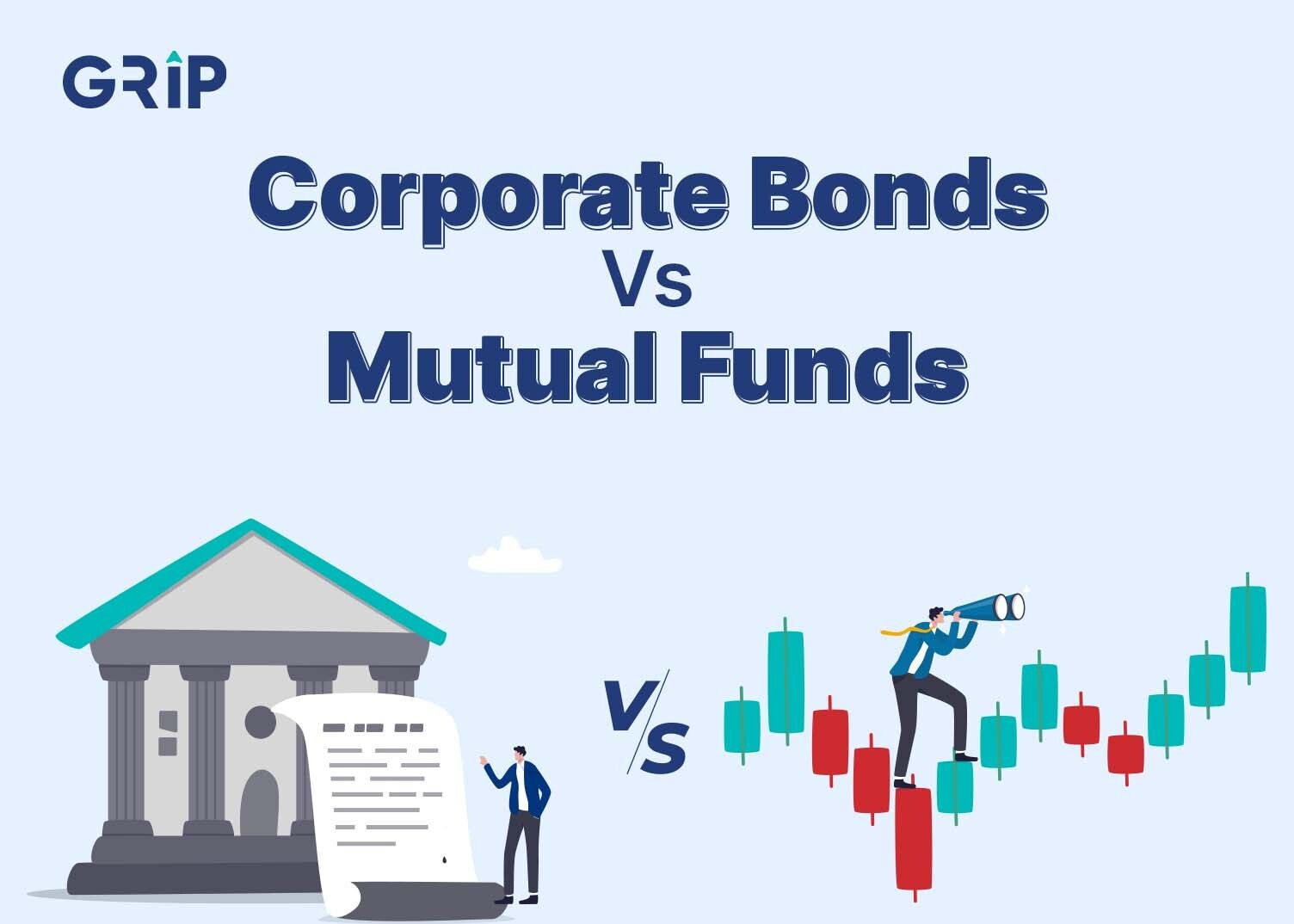Bonds vs Mutual Funds: Learn the key differences

When seeking steady and affordable returns, investors have historically been drawn to assets like gold, real estate, provident funds, and fixed deposits. But every now and then these routes yield returns so low that they cannot stave off the inflation curse. Here, there is also a significant choice between bonds vs mutual funds. Both offer varying degrees of risk and return potential, making them crucial considerations in any diversified investment portfolio.
Investors shift to stocks and mutual funds in order to achieve higher returns. While investments have a large potential to increase wealth, their return stability is sometimes called into question by market swings. By diversifying portfolios and providing less risk than equities, bonds, on the other hand, close a gap in the market and beat FDs and savings accounts.
Investors need to make decisions based on their financial goals and risk tolerance. A thorough understanding of the distinctions between mutual funds and bonds is necessary to make wise investing choices.
What Elements Make Up a Bond?
A bond is a specific type of debt instrument that symbolizes a loan that a government or corporation has taken out to achieve specific financial goals. In this case, investors are the lenders buying the bond, and the borrower is the issuing corporation, which might be the government or a business.
Important terminology in bond investing:
The date on which the face value of the bond is expected to be paid is known as the maturity date.
Face Value:
The maturity value of the bond, which forms the basis for calculating interest payments.
Issue Price:
The initial selling price of the bond.
Coupon Rate:
The interest rate, which may be calculated monthly, semi-annually or annually, and is applied to the face value of the bond.
Coupon Date:
The day on which investors receive their interest payments.
Bond Yield:
Determined by dividing the bond price by the annual coupon payment. This is the return on coupon payments.
Credit risk:
The possibility that the issuer will not pay the amount or interest due.
Types of Bonds:
Bonds can be categorized based on the issuer in the following ways:
Government bonds are issued by the federal, state, or local governments and are typically low-risk instruments with minimal default risk.
Corporate Bonds:
These bonds are issued by companies, which could be large corporations or tiny startups. Public Sector Bonds are issued by PSUs, which hold a majority ownership by the government of over 51%. Bonds can also be divided into groups based on how well they are protected from default:
Senior Secured Bonds:
Accomplished with particular collateral that will be returned in the event of a default.
Senior Unsecured Bonds:
They are superior to other unsecured debt and equity holders, but they are not backed by any particular assets.
Subordinated Bonds:
Affirmed last in the event of default, immediately prior to equity holders.
To get more knowledge about activities regarding Finance then click here.
Other Bonds:
Sovereign Gold Bonds (SGBs):
As an alternative to physical gold, these bonds offer tax advantages if held to maturity as well as returns that exceed the capital appreciation of gold.
Advantages of Bond Investing:
- The first advantage of investing in bonds is that they offer safer returns than stocks and mutual funds as they are less risky and volatile.
- They offer better returns than FDs or savings accounts.
- Bonds allow investors to adjust their investment horizon as they come in different maturities.
- They serve as a security blanket and often outperform real estate and stocks during downturns.
- For people nearing retirement, bonds provide a reliable source of income.
A Mutual Fund: What Is It?
A mutual fund invests in a variety of stocks, bonds, and cash equivalents by pooling the funds of multiple participants under the management of fund managers. The selection of assets is centered on a particular theme, and performance-based adjustments are made over time.
Contributions are made to the fund, and the money contributed is allocated proportionately among the stocks, bonds, and securities in the bucket. Nevertheless, investors only hold mutual fund units—not the underlying assets.
Important Terms for Investing in Mutual Funds:
Asset Management Company (AMC):
This entity oversees the mutual fund and needs to be registered with SEBI in India.
Net Asset Value (NAV):
The cost per unit of a mutual fund determined by dividing the total value of the fund by the quantity of units that are currently in circulation.
Growth and Dividend Option:
While the dividend option distributes gains and payouts on a regular basis, growth reinvests them back into the fund.
Exit Load:
A charge incurred when withdrawing from a fund before the lock-in term expires.
Systematic Investment Plan (SIP):
Facilitates consistent fund contributions.
Units may be periodically transferred between schemes within the same fund house under the terms of the Systematic Transfer Plan.
Mutual fund categories include:
- Equity Mutual Funds: Invest in equities based on the fund’s theme (For example, Large Cap, Mid Cap).
• Debt mutual funds: Make investments in debt securities, such as corporate or government bonds.
• Hybrid mutual funds: Make investments across several asset types, such as bonds and stocks.
Advantages of Mutual Fund Investments:
- One benefit of investing in mutual funds is that they are professionally managed, making them ideal for anyone who lack the time or expertise to manage a portfolio.
Diversified, reducing the possibility that every asset may underperform at once. - Transparent, regulated by SEBI with clear risk profiles.
- Highly liquid, with quick salability.
Comparing Bonds vs Mutual Funds and Stocks
| Individual Stocks | Bonds | Mutual Funds | |
| Risk Exposure | Highest risk exposure | Lower than Stocks and MFs | Higher than Bonds, lower than Stocks |
| Returns | Highest potential returns and losses | Fixed, usually lower than MFs and Stocks | Variable, usually higher than Bonds but can incur losses |
| Liquidity | High | Lower | High |
| Portfolio Management | Investor manages selection and transactions | Investor manages selection and transactions | Experts manage portfolio, investor buys/sells fund units |
| Expense | No extra charges | No extra charges | Management fee charged |
Conclusion
In the Mutual Funds vs Bonds discourse, bonds provide near risk-free fixed returns, whereas mutual funds offer the potential for higher returns with relatively higher risk. Individual stocks present the highest risk and return potential. Investors must balance the nuances of these options against their risk tolerance, goals, and investment timelines to determine the optimal mix.
FAQs on Bonds vs Mutual Funds
Can mutual funds invest in bonds?
Yes, these are known as debt funds.
How to invest in debt funds?
Consider risk appetite, investment horizon, financial goals, exit load, and expense ratio. Platforms like Karvy, CAMS, Coin, ETMoney, and Grow facilitate debt fund investments.
What are short-term debt funds?
Mutual funds that invest in debt maturing in 1-3 years, offering flexibility without long lock-in periods.
Are bonds safer than mutual funds?
Generally, bonds are less risky than stock mutual funds due to lower market volatility. However, bonds do carry risks like credit, inflation, and liquidity risks.
What dangers come with mutual funds?
Market Risk:
Losses due to subpar market performance.
Concentration Risk:
It can be hazardous to concentrate on a single topic (tech stocks during the dot-com bubble, for example).
Liquidity Risk:
Problems with liquidity may arise from excessive selling.
Interest Rate Risk:
As rates rise, the value of the underlying stocks may fall.
What dangers come with bonds?
- Default Risk: The risk of the issuer not making payments as agreed.
- Interest Rate Risk: Bond prices may decline if rates rise.
- Risk of Inflation: Coupons could not rise in value over time.
- Liquidity Risk: The reduced liquidity of the bond market.
- Reinvesting returns at reduced rates is a risk.
Prior to making any bond or mutual fund investments, it is vital to comprehend these hazards.
